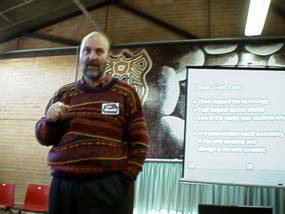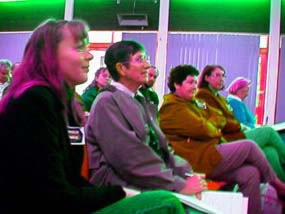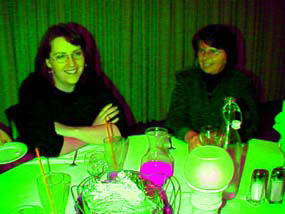Teachers Christian Fellowship of NSW: Conference papers Keynote Address at the TCFNSW RUCAS Conference
Phil Nanlohy, University of Western Sydney

Phil delivers keynote address
Fundamental
change
The arrival of the printing press in the Western hemisphere
fundamentally changed the social, political, economic and cultural
basis of the societies through which this new technology spread.
It was a change as far reaching as the introduction of Information and Communication Technologies (ICT) in the second half of the 20th Century.
ICT has caused a fundamental change in the nature of knowledge
- Textural now audio visual
- Linear now hyperlinked
Located now distributed- Isolated now relational
- Permanent now ephemeral
- Accepted now contested
- Authoritative now provisional


Some of the learners
Two views on the implications of ICT:
1. Incremental integration into pedagogy and curriculum as a support for pedagogy and development of a body of knowledge, skills and understandings.
2. A new paradigm shift with education seen as preparation to manage constant change in what is knowledge through analysis of information and problem solving action.

Some of the learner
Patterns
of classroom ICT use
1. Clip on computing
Locates IT outside students’ learning, resources centralised in
computing room, computing is stand alone activity, software of little
relevance to curriculum, low level of cognitive challenge and no
evidence of new products
2. Curriculum compartments
Limits classroom computing to defined areas of knowledge, setup to
achieve curriculum outcomes for all students, most common use the
publication of students’ final writing copy, most popular programs
feature specific curriculum content, fits readily into teacher’s
program, teacher directed and controlled, can be documented and
assessed.
3. Collaborative computing
Is student directed and the role of teacher is to mediate the learning
environment and support the students.
Mediation assumes a teacher has planned the curriculum, setup the
classroom, set in motion the learning experiences, will continue
reflecting on the students’ needs.


Dennis Ross with digital camera Happy software winner
Collaborative computing encourages self starting, self organising and self monitoring students who have a high output due to engagement in the learning task. It is best with small personal, mobile technology.
What
differences do ICTs make
Research shows that when teachers and learners have routine access to
technology there is higher volume and quality of student output with
more group work and cooperation, more student choices and teachers
developing different philosophies of teaching. Because the current
generation of children are the first of the information age the
implications for teachers are that they need to learn new literacy from
their students because the students are the most adept at interpreting
the information literacies that are so new to their teachers.
Computing can do more than increase the efficiency, speed reliability and comprehensiveness of our mental efforts: it can actually change the tasks problem solvers are faced with and thus alter the cognitive processes involved in solving these tasks. Thus, computers can bring about change in the forms of thought itself. (Helga Rowe 1993)
Other educationalists suggest that the cognitive technologies humans invent serve as instruments of cultural redefinition. As children move from being consumers (rememberers) of knowledge in print form they need to become the producers of information in order to understand their world.
ICT rich
school settings
Students:
- Spend more time in class on task and enjoy learning more
- Are more engaged in higher order learning, synthesising and analysing
- Engage in more cooperative learning and problem solving
Learn thinking skills and develop confidence and self esteem.
Pedagogy
- Becomes more facilitative and less directive
- New types of problem solving and information synthesis are engendered
- Abstract material can be approached in new and more concrete ways
- Provides for a wide range of student abilities
- Technology enables more sharing of students’ work.
School organization
- Physical layout of classroom changes with students seated in groups around a hub
- Increase in the number of non-teaching staff.
Transformative
teaching
The focus in the future must be on teachers acquiring
knowledge and skills which will allow them to utilise the capacity of
digital information technology to create learning environments very
different form most of those which have characterised traditional
classrooms. (Quality Matters, G Ramsey Page 73, Department of
Education and Training Sydney 2000)
Pedagogy, learning, technology and teaching are the foundations of the modern classroom. The order is not the issue but their interrelationship and the engagement of ICTs by teachers will determine the educational outcomes of today’s students.
For many teachers the need is to think beyond the technology, to feel beyond the techno phobia and to live the reality their students inhabit. In a post modern world uncertainty is the only certainty and change the only constant.